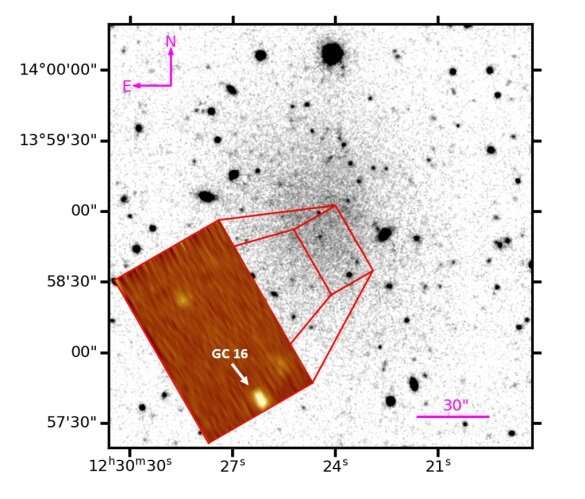May 13, 2020 report
Ultra-diffuse galaxy VCC 1287 investigated in detail

Astronomers have probed an ultra-diffuse galaxy (UDG) known as VCC 1287 with the Keck Cosmic Web Imager (KCWI) in order to investigate its nature. The new results provide essential information about the galaxy's mass and stellar kinematics. The study was presented in a paper published May 6 on arXiv.org.
UDGs are extremely low-density galaxies. The largest UDGs have sizes similar to the Milky Way, but have only about 1% as many stars as our home galaxy. The mystery of UDGs is still baffling scientists as they try to explain why these faint but large galaxies are not ripped apart by the tidal field of their host clusters.
Located some 50 million light years away, VCC 1287 is a UDG with an estimated mass of about 4.5 billion solar masses, assumed to be associated with the Virgo cluster. It is one of the first UDGs to have its mass derived, and previous observations of this galaxy suggest that it is a dark matter dominated system.
A team of astronomers led by Jonah S. Gannon of the Swinburne University, Australia, took a closer look at VCC 1287. They analyzed the data from the KCWI instrument mounted on the Keck II telescope at the W. M. Keck Observatory in order to examine stellar kinematics of VCC 1287 and to put further constraints on the mass of this galaxy.
"Here, we present a kinematical analysis of the Virgo cluster ultra-diffuse galaxy (UDG) VCC 1287 based on data taken with the Keck Cosmic Web Imager," the astronomers wrote in the paper.
The study found that VCC 1287 has a stellar recessional velocity of about 1,116 km/s, which confirms its association with the Virgo cluster and with its globular cluster system reported by previous observations. The astronomers added that the confirmed association of VCC 1287 with Virgo formalizes its large size and its status as a UDG.
According to the paper, VCC 1287 has a stellar velocity dispersion of about 19 km/s, which implies a dynamical mass of approximately 1.11 billion solar masses and mass-to-light ratio at a level of 13, within the galaxy's half light radius.
"This places VCC 1287 slightly above the well-established relation for normal galaxies, with a higher mass-to-light ratio for its dynamical mass than normal galaxies," the researchers noted.
Moreover, the scientists estimated the halo mass of VCC 1287 from its globular cluster system. It was found that its halo mass is around 110 billion solar masses. This, according to the authors of the paper, suggests that VCC 1287 likely resides in a cored or low concentration dark matter halo.
Taking into account all the new results, the astronomers concluded that tidal effects or stellar feedback could have played a key role in the formation of VCC 1287. They added that the feedback scenario could be further investigated by stellar population analysis as galaxies with strong stellar feedback are found to have alpha element enhancement.
More information: On the Stellar Kinematics and Mass of the Virgo Ultra-Diffuse Galaxy VCC 1287, arXiv:2005.03041 [astro-ph.GA] arxiv.org/abs/2005.03041
© 2020 Science X Network




















